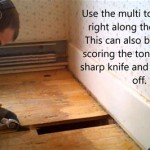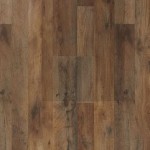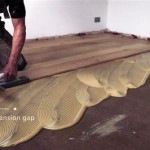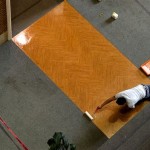Hickory Engineered Flooring: A Comprehensive Overview
Hickory engineered flooring represents a popular choice for homeowners and builders seeking a balance of aesthetic appeal, durability, and cost-effectiveness. Unlike solid hickory flooring, which is constructed from a single piece of hickory wood, engineered hickory flooring comprises multiple layers bonded together. Understanding the construction, advantages, disadvantages, and maintenance requirements of this flooring option is crucial for making an informed decision about its suitability for specific applications.
The core of engineered hickory flooring typically consists of several layers of plywood or high-density fiberboard (HDF). These layers are arranged with their grain running in different directions, a technique known as cross-ply construction. This cross-ply construction provides enhanced dimensional stability compared to solid wood, making engineered hickory flooring less susceptible to warping, shrinking, or expanding with fluctuations in humidity and temperature. Attached to this core is a top layer, or veneer, of genuine hickory wood. This veneer provides the aesthetic appeal of solid hickory flooring, allowing for various grades, cuts, and finishes.
The Construction of Engineered Hickory Flooring
The multi-layered construction of engineered hickory flooring is a key factor in its performance. Each layer contributes to the overall stability and durability of the product. The core layers, typically composed of plywood or HDF, provide the foundational strength and resistance to moisture. Plywood cores are known for their stability and ability to withstand moisture, while HDF cores offer a smooth and dense surface. The number of core layers can vary, with more layers generally indicating greater stability.
The hickory veneer, also known as the wear layer, is the visible surface of the flooring. Its thickness directly affects the lifespan and refinishing potential of the flooring. Thicker veneers allow for more sanding and refinishing, extending the flooring's useful life. Thinner veneers, while more cost-effective, may not be suitable for high-traffic areas or repeated refinishing. The veneer is available in various grades, reflecting the natural characteristics of the hickory wood. These grades determine the presence and size of knots, color variations, and grain patterns, influencing the overall aesthetic.
The manufacturing process involves bonding these layers together under high pressure and heat, utilizing strong adhesives. The quality of the adhesives and the precision of the bonding process are critical to the longevity and performance of the engineered flooring. Reputable manufacturers adhere to strict quality control standards to ensure that their products meet industry benchmarks for strength, stability, and resistance to delamination.
Advantages of Hickory Engineered Flooring
Engineered hickory flooring offers several advantages over solid hickory flooring and other flooring materials. Its dimensional stability makes it suitable for installation in areas with varying humidity levels, such as basements and bathrooms. This resistance to warping and cupping eliminates the need for expansion gaps typically required with solid wood flooring, resulting in a cleaner, more seamless appearance.
Another significant advantage is its versatility in installation methods. Engineered hickory flooring can be installed using various techniques, including glue-down, nail-down, and floating installations. Floating installations, where the planks are connected to each other but not directly to the subfloor, are particularly convenient for DIY projects and can be installed over existing flooring. Glue-down installations provide a more stable and permanent installation, while nail-down installations are typically used over wooden subfloors.
Cost-effectiveness is another key benefit. Engineered hickory flooring is generally less expensive than solid hickory flooring, primarily due to the more efficient utilization of the hardwood. The engineered construction allows manufacturers to use less hickory wood while still providing the desired aesthetic and durability. This cost advantage makes it an attractive option for budget-conscious homeowners.
The availability of various finishes and styles further enhances the appeal of engineered hickory flooring. Manufacturers offer a wide range of colors, textures, and plank sizes, allowing for customization to suit different design preferences. From smooth, contemporary finishes to rustic, hand-scraped textures, there are options available to complement any interior décor.
Considerations and Maintenance
Despite its advantages, engineered hickory flooring also presents certain considerations. While the hickory veneer provides the look and feel of solid wood, it is still a thin layer over a manufactured core. This means that the veneer can be susceptible to scratches and dents, especially in high-traffic areas. Choosing a product with a thicker wear layer and a durable finish can help mitigate this risk.
The refinishing potential of engineered hickory flooring is limited by the thickness of the veneer. Flooring with a thicker veneer can be sanded and refinished multiple times, while flooring with a thinner veneer may only allow for one or two refinishing cycles, or none at all. Therefore, it is crucial to consider the long-term maintenance needs and choose a product with a sufficient veneer thickness if refinishing is a priority.
Proper maintenance is essential for preserving the appearance and longevity of engineered hickory flooring. Regular cleaning with a damp mop and a pH-neutral cleaner is recommended. Avoid using excessive water or harsh chemicals, as these can damage the finish and penetrate the seams. Placing mats at entryways and using furniture pads can help prevent scratches and dents. Periodically re-coating the finish can also help maintain its luster and protect the underlying veneer.
The lifespan of engineered hickory flooring depends on several factors, including the quality of the product, the thickness of the veneer, the level of traffic, and the quality of maintenance. With proper care, engineered hickory flooring can last for several decades, providing a durable and aesthetically pleasing flooring solution.
Installation can also present challenges. While some installation methods, such as floating floors, are relatively straightforward, others, such as glue-down installations, require specialized tools and expertise. Incorrect installation can lead to issues such as uneven surfaces, gapping between planks, and premature wear. It is often advisable to hire a professional installer to ensure a proper and long-lasting installation.
The environmental impact of engineered hickory flooring is another consideration. While hickory is a renewable resource, the manufacturing process involves the use of adhesives and other chemicals. Choosing products that are certified by organizations such as the Forest Stewardship Council (FSC) or that meet low-VOC emission standards can help minimize the environmental footprint. These certifications indicate that the wood is sourced from sustainably managed forests and that the manufacturing process adheres to environmentally responsible practices.
Furthermore, the suitability of engineered hickory flooring for specific applications should be carefully evaluated. While its dimensional stability makes it suitable for basements and bathrooms, prolonged exposure to standing water should still be avoided. In areas with high humidity, it is advisable to choose a product with a water-resistant core and a durable finish. In areas with heavy foot traffic, a thicker veneer and a harder finish are recommended.
In summary, engineered hickory flooring offers a compelling combination of aesthetic appeal, durability, and cost-effectiveness. Its multi-layered construction provides enhanced dimensional stability and versatility in installation. However, it is essential to consider the thickness of the veneer, the refinishing potential, and the maintenance requirements before making a purchase. By carefully evaluating these factors and choosing a high-quality product from a reputable manufacturer, homeowners can enjoy the beauty and durability of hickory flooring for many years to come.
Ultimately, the selection of a specific engineered hickory flooring product should be based on a comprehensive assessment of individual needs, preferences, and budget. Consulting with flooring professionals can provide valuable insights and guidance in making the right choice for specific applications.

Virginia Mill Works 9 16 In Rustic Hickory Engineered Hardwood Flooring 7 5 Wide Ll

Bellawood Artisan 1 2 In Nautilus Hickory Wire Brushed Engineered Hardwood 7 4 Wide Ll Flooring

Plant Street Hickory Wood Flooring District Floor Depot

Bellawood 3 8 In Bora Peak Hickory Engineered Hardwood Flooring 6 5 Wide Ll

1 2 X 7 Talon Semi Gloss Engineered Natural Hickory Hardwood Cabinets To Go

Mayflower 3 4 In Millrun Hickory Solid Hardwood Flooring 25 Wide Ll

Discount 5 X 1 2 Hickory Character Hand Sc 3mm Wear Layer Prefinished Engineered Hardwood Flooring By Hurst Hardwoods

Engineered Hickory Flooring Carlisle Wide Plank Floors

What Is Hickory Wood Flooring Discover Timeless Elegance Mr Sander

Engineered Hickory Shoreline Maine Traditions Hardwood Flooring








